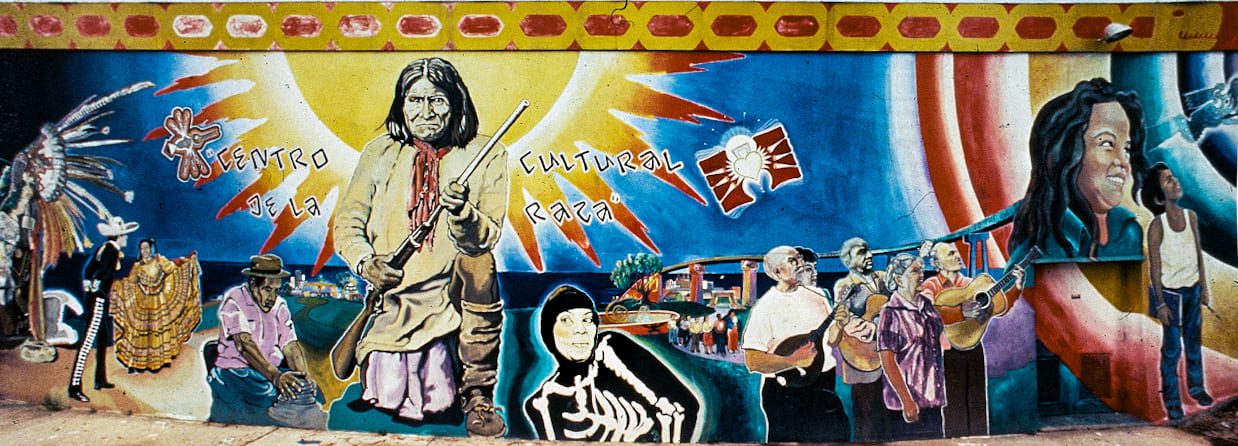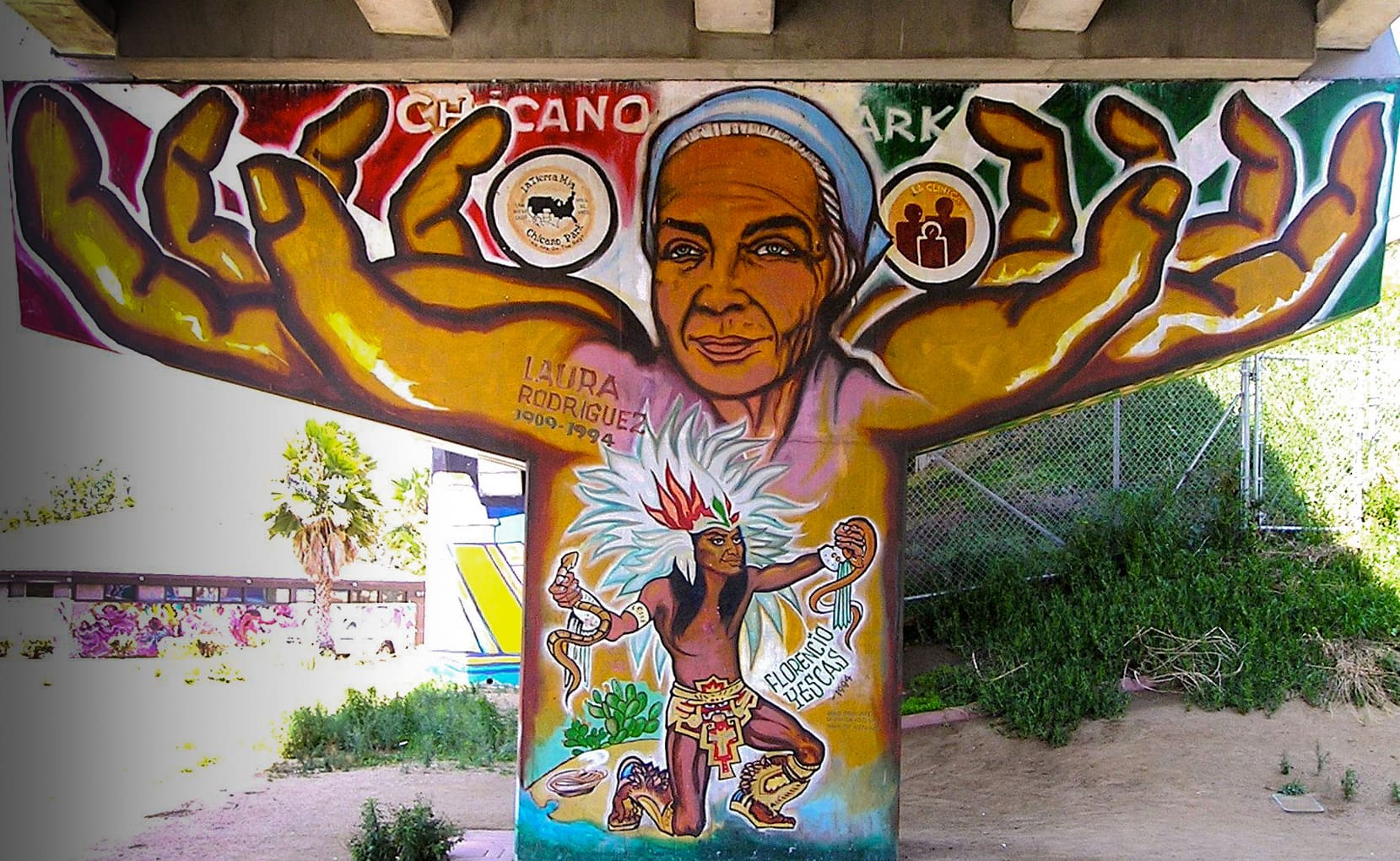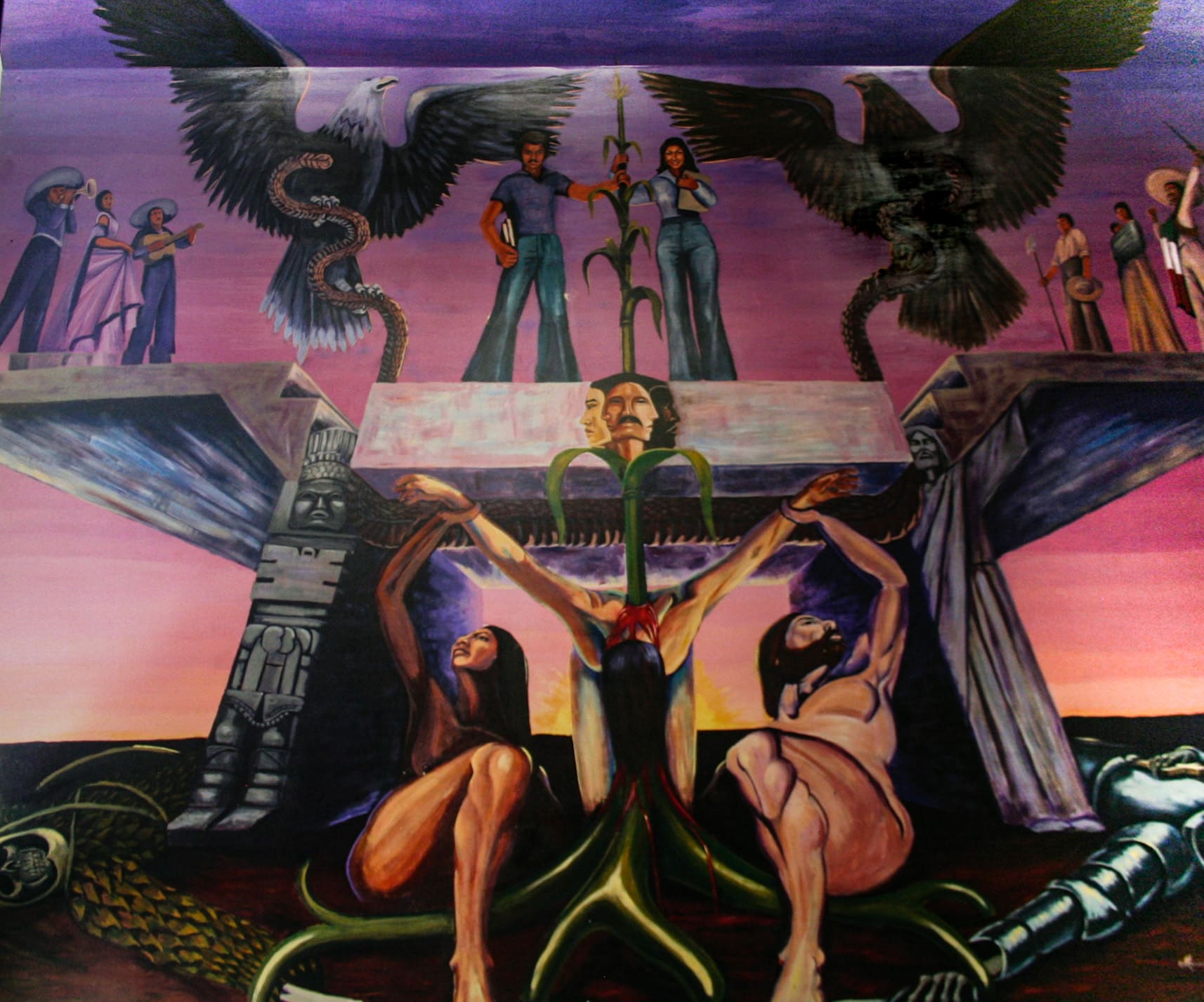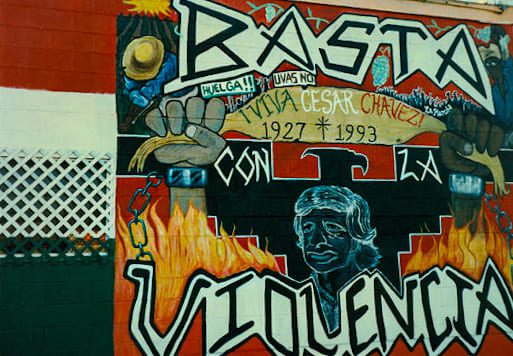
English
Español
A Xicana Re-Vision of the Chicano Mural Movement
As a Xicana feminist scholar contributing to a social art history that re-contextualizes Chicano/a muralism, I write about Chicano muralism using a Xicana feminist “re-vision.” My positionality as a first-generation Xicana artist is an integral aspect of my visual analysis because I analyze Chicano muralism without strictly abiding to the standard of the three greats in Mexican muralism; Diego Rivera, David Siqueiros, and José Clemente Orozco. I am very familiar with Mexican murals not just because of my academic training but also through my upbringing as Mexican American with Mexican parents, Mexican and Indigenous grandparents, and with family members still living in Mexico. I approach the analysis of Chicano murals as uniquely their own thing — with some influence from the Mexican muralists. Typically, art historical methodologies do not involve subjectivity and identity as part of the analytical strategy of interpreting an image, which arguably is why my dissertation is a form of activism. I view and engage with the history of Chicana/o murals through a personal familiarity and not simply to objectify or distance myself from it. My visual analysis on Chicano murals incorporates a lens or perspective that emphasizes the experiences of womxn of color artists in the Chicano art movement in what I introduce as a “Xicana re-vision” of the Chicano mural movement.
The term “Xicano/a/x” is derived from what scholar Dylan A.T. Miner referred to as “Xicano/a” as people who are generally known as Chicanos or Mexican Americans but “pay particular attention to the Indigenist turn in Xicano identity and politics. From this perspective, to be Xicano is to be Indigenous. This spelling pays homage to the use by activists and artists who, for decades, have employed this spelling in reference to written Náhuatl” (Miner, Creating Aztlán, University of Arizona Press, 2014, 221). The term “Xicanista” introduced by Chicana feminist scholar Ana Castillo is defined as an “activista (female activist), when her flesh, mind and soul serve as a lightning rod for the confluence of her consciousness (not just Chicana, not activista for La Raza, not only a feminist but Chicana feminist), is the new generation of women that now has documentation of her particular history in the form of books, plays, murals, art, and even films that the culturalists have produced” (Castillo, Massacre of the Dreamers, University of New Mexico Press, 1994, 100-101).
The use of the term Xicano/a/x compared to Chicano/a/x is a complicated debate that continues today in academic and public forums. I intentionally use the term Xicana/x because of my connection to indigeneity through my grandparents, my academic training, and to respectfully acknowledge Indigenous people, language, and culture as American art. In addition, I write about womxn of color as artists, activists, but also as the protagonists of the Chicano art movement. My inquiries revolve around the general history of Chicano murals. What is the known history of womxn artists/muralists in the Chicano art movement since the mid 1960s? What are portable murals? What imagery and materials are used to create the portable murals? The early period of “Chicano muralism,” or the Chicano mural movement, between 1966 to 1970 was described by art historian Alan W. Barnett as Chicano “community murals” that were a form of “activism with a direct impact on the notion of identity, socio-political issues, and community outreach” (Barnett, Community Murals: The People’s Art, Art Alliance Press, 1984, 65). As the Chicano movement gained momentum art historian Shifra M. Goldman described the art movement as a “grassroots explosion” of artistic production which could be considered a “Chicano Renaissance.” Goldman compared the Chicano art and mural movement to the Harlem Renaissance (Goldman, Dimensions of the Americas, University of Chicago Press, 1994, 300).
During this “Chicano Renaissance '' period, from the late 1960s to the early 1970s, the creative strides made by womxn artists, some of which became full-time muralists while others produced murals occasionally, must be accounted for. For example, Chicana artist Carlotta d.R. Espinoza produced two portable murals on canvas titled Mujeres Heroes (Women Heroes) now destroyed and a surviving mural titled A Tribute to Three Mexican Heroes. Both murals were created in Colorado as a response to the Chicano Movement in Denver as early as 1968. I also analyze Espinoza’s portable murals alongside other womxn artists and muralists in California. This includes artists such as Judith F. Baca, Barbara Carrasco, Yreina Cervantez, who are commonly known in Los Angeles to other areas of California such as Chicana and Latina artists Carmen Léon, Juana Alicia, and Patricia Rodríguez in the San Francisco Bay Area. My research demonstrates the interconnecting ideas of the Chicano art movement, showcasing the possibilities of social justice and self-representation within each mural, but also acknowledging the artist — whether they identify as Chicana/x, Latina/x, Mexican, Mexican American, Hispanic, Indigenous, or Central American. I write womxn artists and muralists into Chicano mural history to enrich the canon on muralism in the Americas. Mexican muralists and artists such as Aurora Reyes, Rina Lazo Wasem, and María Izquierdo also join the ranks of this elite group of womxn artists who envisioned a more just future.
As I write, I am reminded of what Chicana/x feminist scholar Gloria E. Anzaldúa wrote about Chicano/a art and the use of the Indigenous language Náhuatl to express a connection to indigeneity but also to uplift it. In the early 1990s, she wrote about her experience visiting the Denver Museum of Natural History to view the exhibition titled Aztec: The World of Moctezuma. Anzaldúa described the voice of Chicano actor Edward James Olmos narrating the audio tour speaking in Náhuatl and said, “Though I wonder if Olmos and we Chicana/o writers and artists also are misappropriating the Náhuatl language and images, hearing the words and seeing the images boosts my spirits.” She continued to add, “I feel that I am part of something profound outside my personal self. This sense of connection and community compels Chicana/o writers/artists to delve into, sift through, and re-work native imagery” (Keating ed., Anzaldúa, “Border Arte: Nepantla el luger de la Frontera,” in The Gloria E. Anzaldúa Reader, Duke University Press, 2009, 177-178). Anzaldúa’s acknowledgement of “border arte and artists” as change makers, disrupters, influencers, and original creators of their own narratives provides the foundation for new generations of Xicano/a/x artists and muralists to thrive.
Gaby R. Gomez @profeladyxoc
Una Re-visión Xicana del Movimiento Mural Chicano
Como académica feminista Xicana contribuyo a una historia del arte social que recontextualiza el muralismo, escribiendo sobre el muralismo chicano usando una “revisión” feminista Xicana. Mi posicionamiento como artista Xicana de primera generación, es un aspecto integral de mi análisis visual, debido a que analizo este muralismo sin ceñirme, estrictamente, al estándar de los tres grandes del muralismo mexicano que son: Diego Rivera, David Alfaro Siqueiros y José Clemente Orozco.
Estoy muy familiarizada con los murales mexicanos, no solo por mi formación académica, sino también por mi educación como mexicoamericana con padres mexicanos, abuelos mexicanos e indígenas y con familiares que aún viven en México. Me acerco al análisis de los murales como algo exclusivamente propio, con cierta influencia de los muralistas mexicanos. Por lo general, las metodologías en la historia del arte no involucran la subjetividad y la identidad como parte de la estrategia analítica para interpretar una imagen, lo que podría decir el por qué mi disertación es una forma de activismo.
Veo y me comprometo con la historia de los murales de Chicana/o, a través de una familiaridad personal y no simplemente para objetivarme o distanciarme de ella. Mi análisis visual de estas obras, incorpora una lente o perspectiva que enfatiza las experiencias de las mujeres artistas de color en el movimiento de arte chicano, en lo que presento como una “re-visión Xicana” del Movimiento Mural Chicano.
El término “Xicano/a/x” se deriva de lo que el erudito Dylan A.T. Miner definió como “Xicano/a” para referirse a las personas que, generalmente, son conocidas como chicanos o mexicoamericanos pero que “prestan especial atención al giro indigenista en la identidad y la política de los Xicanos. Desde esta perspectiva, ser Xicano es ser indígena. Esta ortografía rinde homenaje al uso que, durante décadas, activistas y artistas han empleado en referencia al náhuatl escrito” (Miner, 2014, p. 221).
El término “Xicanista”, introducido por la estudiosa feminista chicana Ana Castillo, se define como una “activista (mujer activista), cuando su carne, mente y alma sirven como un pararrayos para la confluencia de su conciencia (no solo chicana, sino activista para La Raza, no solo feminista, sino feminista chicana), es la nueva generación de mujeres que ahora tiene documentación sobre su historia particular en forma de libros, obras de teatro, murales, arte e incluso películas que han producido los culturalistas” (Castillo, 1994, pp. 100-101).
El uso del término Xicano/a/x en comparación con Chicano/a/x, es un debate complicado que continúa hoy en foros académicos y públicos. Utilizo intencionalmente el término Xicana/x debido a mi conexión con la indigeneidad a través de mis abuelos, mi formación académica y para reconocer respetuosamente a los pueblos, los idiomas y las culturas indígenas como arte estadounidense. Además, escribo sobre mujeres de color como artistas, activistas, pero también, como protagonistas del movimiento de arte chicano. Mis consultas giran en torno a la historia general de los murales chicanos: ¿Cuál es la historia conocida de las mujeres artistas/muralistas del movimiento de arte chicano desde mediados de la década de 1960? ¿Qué son los murales portátiles? ¿Qué imágenes y materiales se utilizan para crear los murales portátiles?
El período inicial del “muralismo chicano” o el Movimiento Muralista Chicano, entre 1966 y 1970, fue descrito por el historiador de arte Alan W. Barnett como “murales comunitarios” chicanos que eran una forma de “activismo con un impacto directo en la noción de identidad, cuestiones sociopolíticas y de alcance comunitario” (Barnett, 1984, p. 65). A medida que el movimiento chicano ganaba impulso, la historiadora del arte Shifra M. Goldman, lo describió como una “explosión de base” de producción artística que podría considerarse un “Renacimiento Chicano”. Goldman comparó el arte chicano y el movimiento mural con el Renacimiento de Harlem (Goldman, 1994, p. 300).
Durante este período del “Renacimiento Chicano”, se deben tener en cuenta los avances creativos realizados por mujeres artistas, algunas de las cuales se convirtieron en muralistas de tiempo completo, mientras que otras produjeron murales ocasionalmente. Por ejemplo, la artista chicana Carlotta D.R. EspinoZa produjo dos murales portátiles sobre lienzo titulados: Mujeres Héroes ahora destruidos y un mural sobreviviente titulado: A Tribute to Three Mexican Heroes. Ambos fueron creados en Colorado como respuesta al Movimiento Chicano en Denver desde 1968.
También analizo los murales portátiles de EspinoZa junto con otras mujeres artistas y muralistas en California, que incluye a artistas como: Judith F. Baca, Barbara Carrasco, Yreina Cervantez, quienes son comúnmente conocidas en Los Ángeles y, en otras áreas de California, como las artistas chicanas y latinas: Carmen León, Juana Alicia y Patricia Rodríguez en el Área de la Bahía de San Francisco. Mi investigación demuestra las ideas interconectadas del movimiento de arte chicano, mostrando las posibilidades de justicia social y autorrepresentación dentro de cada mural, pero también reconociendo al artista, ya sea que se identifique como chicana/x, latina/x, mexicana, mexicoamericana, hispana, indígena o centroamericana. Escribo a mujeres artistas y muralistas sobre la historia del mural chicano para enriquecer el canon sobre el muralismo en las Américas. Muralistas y artistas mexicanas como Aurora Reyes, Rina Lazo Wasem y María Izquierdo también se suman a las filas de este grupo élite de mujeres artistas que imaginaron un futuro más justo.
Mientras escribo, recuerdo lo que la estudiosa feminista chicana/x Gloria E. Anzaldúa plasmó sobre el arte chicano/a y el uso de la lengua indígena náhuatl, para expresar una conexión con la indigeneidad, pero también para elevarla. A principios de la década de 1990, escribió sobre su experiencia al visitar el Museo de Historia Natural de Denver para ver la exposición titulada: Aztec: The World of Moctezuma. Anzaldúa describió la voz del actor chicano Edward James Olmos al narrar la audioguía hablando en náhuatl y dijo: “Aunque me pregunto si Olmos y nosotros, los escritores y artistas chicanos/x, también nos estamos apropiando indebidamente del idioma náhuatl y de las imágenes, escuchando las palabras y viendo las imágenes, levanta mi ánimo”. Continuó agregando: “Siento que soy parte de algo profundo fuera de mi ser personal. Este sentido de conexión y comunidad obliga a los escritores/artistas chicanos/as a profundizar, tamizar y reelaborar las imágenes nativas” (Keating ed., Anzaldúa, 2009, pp. 177-178). El reconocimiento de Anzaldúa del “arte y los artistas fronterizos” como creadores de cambios, disruptores, influyentes y creadores originales de sus propias narrativas, proporciona la base para que prosperen las nuevas generaciones de artistas y muralistas Xicano/a/x.

We are Not a Minority
1978
Congreso de Artistas Chicanos en Aztlan (Mario Torero with Zapilote, Rocky, el Leon) Zade
Los Angeles, California

The Great Wall of Los Angeles
1974
Judith F. Baca
Los Angeles, California

The Great Wall of Los Angeles
1974
Judith F. Baca
Los Angeles, California

The Great Wall of Los Angeles
1974
Judith F. Baca
Los Angeles, California

The Great Wall of Los Angeles
1974
Judith F. Baca
Los Angeles, California

The Great Wall of Los Angeles
1974
Judith F. Baca
Los Angeles, California

The Great Wall of Los Angeles
1974
Judith F. Baca
Los Angeles, California

The Great Wall of Los Angeles
1974
Judith F. Baca
Los Angeles, California

Ramona Lisa
n.d. | s.f.
Levi Ponce
Los Angeles, California

Untitled (Homeboy)
1974
Manuel Cruz
Los Angeles, California

Latinoamerica
1974
Las Mujeres Muralistas (Patricia Rodriguez, Graciela Carrillo, Consuelo Mendez, Irene Perez)
Los Angeles, California

La Ofrenda
1989
Yreina Cervantez
Los Angeles, California

Hecho a Mano
2020
Sonia Romero Photographer: Elon Schoenholz
Los Angeles, California

Hecho a Mano
2020
Sonia Romero Photographer: Elon Schoenholz
Los Angeles, California

Lady of the Valley
2001
Levi Ponce and Ernie "Serv One" Rojas. Photographer: Javier Martinez
Los Angeles (Pacoima), California

La Familia
1977
Wayne Alaniz-Healy and David Rivas Botella
Los Angeles, California

Chicano History mural
1970
Eduardo Carrilo, Sergio Hernandez, Ramses Noriega, and Saul Solache
Los Angeles, California

Geronimo
1981
Victor Ochoa
San Diego, California

Laura Rodriguez
n.d.
Mario Torero
San Diego, Chicano Park, California

The Return of Quetzalcoatl
1973
CACA Congreso de Artistas Chicanos en Aztlán
San Diego, Chicano Park, California

Kiosko
n.d.
Alfredo Larin and Chicano Park Community
San Diego, Chicano Park, California

Luna Bliss
2018
Victor Marka27 Quiñonez
Lynn, Massachusetts

Las Lechugueras
2000s
Juana Alicia
San Francisco, California

Huitzilophochtli
2009
David Ocelotl Garcia
Denver, Colorado

La Antorcha de Quetzalcoatl
n.d.
Leo Tanguma
Denver, Colorado

Façade
n.d.
Carlos Fresquez & MSU Students from “Community Painting: The Mural” Course
Denver, Colorado

Homage to Peoria's Past
2009
Emanuel Martinez
Denver, Colorado

Staff of Life
1976
Emanuel Martinez
Denver, Colorado

Neo Indigenous
2016
Victor Marka27 Quiñonez
Denver, Colorado

Song of Unity
1978
Common Arts (Ray Patlan, Osha Neumann, Anna de Leon, O’Brien Thele)
Berkeley, California

Alma Indigena
2021
Victor Marka27 Quiñonez
Washington, DC

Mayahuel
2001
Rock Martinez
Tucson, Arizona

Corazon Del Pueblo
2011
David Ocelotl Garcia
Pueblo, Colorado

American Painting
2013
Gabriel Villa
Chicago, Illinois

Searching for Mentors in Memories
2016
Sam Kirk
Chicago, Illinois

Declaration of Immigration
2009
Salvador Jiménez
Chicago, Illinois

Declaration of Immigration
2009
Salvador Jiménez
Chicago, Illinois

Cucurrucucú My Love
n.d.
Chema Skandal
Chicago, Illinois

Cucurrucucú My Love
n.d.
Chema Skandal
Chicago, Illinois

Southside Park Mural
Original 1969 - Restored 1977
Royal Chicano Air Force
Sacramento, California

1846 We are Indigenous, Not Illegal
2020
Victor Marka27 Quiñonez
Boulder, Colorado

Virgen Indigena
2004
Jane Madrigal, Jose Cosme, & Louie Alejandro
San Antonio, Texas
Courtesy of San Anto Cultural Arts

Leyendas Aztecas
1998
Israel “Izzy” Rico
San Antonio, Texas
Courtesy of San Anto Cultural Arts

Familia y Cultura
Original 1995 - Restored 2011
Debbie Esparza, Juan Ramos, Andy Rivas, Angel Hernandez, Brandy Salinas, Eduardo Urbano, Enrico Salinas, Jessica Garcia, Juan Francisco, Ruben Serafin
Damien Salkin & youth team
San Antonio, Texas
Courtesy of San Anto Cultural Arts

Tradición y Cultura
Original 2001 - Restored 2018
Alex Rubio, Ruth Buentelo, Oscar Flores, Damien Hernandez, Victor Mena
San Antonio, Texas
Courtesy of San Anto Cultural Arts

8 Stages of a Chicana
Original 1995 - Restored 2004 and 2017
Cruz Ortiz, Carlos Espinoza, Cardee, Gerry Garcia, Adriana Abundis & Youth volunteers
San Antonio, Texas
Courtesy of San Anto Cultural Arts

Educacion
Original 1994 - Restored 1999
Adrian "El Caminante" Cervantez, Carlos Herandez, Manuel "MEME" Castillo, Rina "Taco Lady" Moreno, Patti "Bunkhaus" Radle, Luna family siblings, Mike Kokinda; youth volunteers: Angela, "El Bob," El Necio Kid, Ricardo, Emilio, Rebecca Lopez, Eric
San Antonio, Texas
Courtesy of San Anto Cultural Arts

Educacion
Original 1994 - Restored 1999
Adrian "El Caminante" Cervantez, Carlos Herandez, Manuel "MEME" Castillo, Rina "Taco Lady" Moreno, Patti "Bunkhaus" Radle, Luna family siblings, Mike Kokinda; youth volunteers: Angela, "El Bob," El Necio Kid, Ricardo, Emilio, Rebecca Lopez, Eric
San Antonio, Texas
Courtesy of San Anto Cultural Arts

Comprando
Original 1996 - Restored 2007
Mary Helen Herrera, Ricardo Islas, Cardee Garcia, Gerry Garcia, David Blancas, Ruth Buentello, Alvaro Ramirez, Patrick Luna, Alejandro Garcia, Victor "Supher" Zarazua
San Antonio, Texas
Courtesy of San Anto Cultural Arts

Una Mesa Para La Gente
Original 1999 - Restored 2008
Cruz Ortiz, Lisa Veracruz, Ruth Buentello, San Antonio Youth Centers, House of Teens, Fuerza Unida Youth, Southwest Workers YLO, Cardee Garcia, Gerry Garcia, Ana Cavasos, Joseph Cavasos, Melinda Higgins, Imelda, Alejandro Padilla, Fabian Diaz, Adriana Garcia, Rico Salinas, Daisy Hernandez, Yasmin Codina, Clarissa Duran, Charlie, Ricardo Briones, Maricela Olguin, Celeste DeLuna, Alejandro, Cristina Ordonez, Arturo Morales, Eddie Chavez, Michaela Jacobson, Serenity Hernandez
San Antonio, Texas
Courtesy of San Anto Cultural Arts

Insomne de Amor
Original 1999 - Restored 2008
Rigoberto Luna, Ruth Buentello Restoration crew members: Bianca Arguellez, Brian Arista, Kim Bishop, David Blancas, Celeste de Luna, Adriana Garcia, Alejandro Garcia, Cardee Garcia, Christian Rodriguez, Alex Rubio, Alexandra Salinas, Enrico "Caso" Salinas, Julio Trevino
San Antonio, Texas
Courtesy of San Anto Cultural Arts

Mano a Mano
1999
Juan Ramos, Mike Roman, Janette Torres
San Antonio, Texas
Courtesy of San Anto Cultural Arts

Basta Con La Violencia
1997
Israel "Izzy" Rico
San Antonio, Texas
Courtesy of San Anto Cultural Arts

Guadalupe Cultural Arts Centre
n.d.
Jesse Treviño
San Antonio, Texas

End Barrio Warfare
Original 1998 - Restored 2010
Augustine "Fugi" Villa, Lisa Mendiola
San Antonio, Texas
Courtesy of San Anto Cultural Arts

Justice for Vanessa
2020
Ana Hernandez Burwell
San Antonio, Texas

Rebirth of a Nationality
Original 1973 - Restored 2018
Leo Tanguma
Houston, Texas

Rebirth of a Nationality
Original 1973 - Restored 2018
Leo Tanguma
Houston, Texas

Rebirth of a Nationality
Original 1973 - Restored 2018
Leo Tanguma
Houston, Texas

Trinity
2016
Victor Marka27 Quiñonez
Worcester, Massachusetts

Los Angeles, California

Los Angeles, California

Los Angeles, California

Los Angeles, California

Los Angeles, California

Los Angeles, California

Los Angeles, California

Los Angeles, California

Los Angeles, California

Los Angeles, California

Los Angeles, California

Los Angeles, California

Los Angeles, California

Los Angeles, California

Los Angeles (Pacoima), California

Los Angeles, California

Los Angeles, California


San Diego, California

San Diego, Chicano Park, California

San Diego, Chicano Park, California

San Diego, Chicano Park, California

Lynn, Massachusetts

Juana Alicia
San Francisco, California

Denver, Colorado

Denver, Colorado

Denver, Colorado

Denver, Colorado

Denver, Colorado

Denver, Colorado

Berkeley, California

Washington, DC

Tucson, Arizona

Pueblo, Colorado

Chicago, Illinois

Chicago, Illinois

Chicago, Illinois

Chicago, Illinois

Chicago, Illinois

Chicago, Illinois

Sacramento, California

Boulder, Colorado

San Antonio, Texas
Courtesy of San Anto Cultural Arts

San Antonio, Texas
Courtesy of San Anto Cultural Arts

San Antonio, Texas
Courtesy of San Anto Cultural Arts

San Antonio, Texas
Courtesy of San Anto Cultural Arts

San Antonio, Texas Courtesy of San Anto Cultural Arts

San Antonio, Texas
Courtesy of San Anto Cultural Arts

San Antonio, Texas
Courtesy of San Anto Cultural Arts

San Antonio, Texas
Courtesy of San Anto Cultural Arts

San Antonio, Texas
Courtesy of San Anto Cultural Arts

San Antonio, Texas
Courtesy of San Anto Cultural Arts

San Antonio, Texas
Courtesy of San Anto Cultural Arts

San Antonio, Texas
Courtesy of San Anto Cultural Arts

San Antonio, Texas

San Antonio, Texas
Courtesy of San Anto Cultural Arts

San Antonio, Texas

Houston, Texas

Houston, Texas

Houston, Texas

Worcester, Massachusetts


